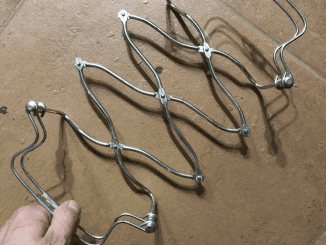Diabetes often develops silently, showing up with subtle signs that many people brush off or misunderstand. According to the Cleveland Clinic, about 37.3 million Americans—roughly 11% of the population—are living with diabetes. What’s troubling is that a large percentage of them don’t realize it until serious complications arise. But here’s the hopeful part: your body usually gives you early warnings. The key is to notice them and take action.
In this article, we’re going to walk through nine of the most overlooked signs of diabetes. Whether you’ve felt a little “off” lately or just want to stay informed, this guide will help you spot the red flags before they turn into health emergencies.
1. Skin Tags: A Tiny Growth With a Bigger Message

Skin tags might seem harmless—and most of the time, they are. These small, soft skin growths often appear on your neck, armpits, or groin. They’re usually painless, but when they start multiplying rapidly or showing up unexpectedly, it could be a sign of insulin resistance. This condition is often linked to type 2 diabetes. While skin tags don’t guarantee a diagnosis, they’re a visual clue that your body may not be managing blood sugar properly. It’s worth getting checked out if you’re noticing more of them.
2. Small Bumps on the Skin: A Symptom of High Triglycerides
Have you noticed clusters of itchy, yellowish bumps on your thighs, buttocks, or elbows? These might be more than just a skin irritation. Known as eruptive xanthomatosis, these bumps can appear when triglyceride levels in the blood are unusually high—something commonly seen in individuals with uncontrolled diabetes. While they may go unnoticed at first, their presence could be a visual warning that your metabolic health needs attention.
3. Feeling Completely Drained, Even After Rest
Everyone feels tired now and then, but diabetes-related fatigue is different. It doesn’t go away after a good night’s sleep or a relaxing weekend. It’s constant. It drags you down and makes even simple tasks feel overwhelming. This kind of exhaustion is often due to fluctuating blood sugar levels, inflammation, or insulin resistance. If your energy tank feels empty no matter what you do, your body could be trying to tell you something more serious is going on.
Video : Diabetes symptoms
4. Dark, Velvety Patches on the Skin
Have you spotted darkened areas of skin—particularly on your neck, armpits, or groin—that feel soft or velvety to the touch? This condition is called acanthosis nigricans. It’s not dangerous, but it often shows up as a result of high insulin levels and is strongly associated with prediabetes or diabetes. If you can’t wash or exfoliate the patches away, it’s time to talk to a healthcare provider. These patches are your skin’s way of waving a red flag.
5. Constant Thirst and Frequent Urination
One of the most classic signs of diabetes is feeling thirsty all the time—and running to the bathroom nonstop. When your blood sugar is too high, your kidneys work overtime to filter and flush it out through urine. As a result, you become dehydrated, which then triggers thirst, creating an exhausting loop. If you find yourself drinking more water than usual but still feeling parched, it may be time to get your blood sugar checked.
6. Blurry Vision That Comes and Goes
Blurry vision might seem like a minor annoyance or a sign that you need new glasses, but it can also be a sign of diabetes. High blood sugar can cause swelling in the lenses of your eyes, which distorts your ability to see clearly. If left untreated, diabetes can damage the blood vessels in your eyes and lead to more severe conditions like diabetic retinopathy. If your vision has changed suddenly, or you’re experiencing blurred sight more often than usual, don’t wait for your next eye exam—get evaluated sooner.

7. Wounds That Seem to Take Forever to Heal
If you get a cut or bruise and it lingers much longer than it should, it might not be just a fluke. Elevated blood sugar levels interfere with your body’s natural healing processes. They also weaken your immune system and impair blood flow, making it harder for your skin and tissues to repair themselves. This is one of the reasons foot ulcers and skin infections are common complications in people with diabetes. Slow-healing wounds are more than an inconvenience—they’re a red flag you shouldn’t ignore.
8. Sudden, Unexplained Weight Loss
Weight loss is usually a goal for many, but if it happens unexpectedly—and without any change in diet or exercise—it could be cause for concern. In people with diabetes, the body isn’t able to properly use glucose for energy. When cells are starved of sugar, the body starts breaking down fat and muscle to compensate. This leads to rapid and unintentional weight loss, often occurring in just a few weeks or months. It’s one of the most noticeable signs of type 1 diabetes, but it can also happen in type 2.
9. Tingling, Burning, or Numbness in Hands and Feet
That “pins and needles” feeling in your extremities could be more than just bad posture. Diabetes can cause damage to small nerves—a condition called diabetic neuropathy. It often starts in the hands, feet, or legs and can range from mild tingling to sharp pain or numbness. Some people describe it as a burning sensation or the feeling of their socks being bunched up, even when barefoot. These symptoms may seem minor at first but can progress quickly if diabetes remains unmanaged.
Video : Best Meals To Lower Blood Sugar Level
Conclusion: Know the Signs, Protect Your Health
The early signs of diabetes are often subtle, but they matter. Your body is constantly communicating, and the clues are there—you just have to pay attention. Catching diabetes early gives you a huge advantage. With proper treatment, lifestyle adjustments, and regular monitoring, you can manage the condition effectively and avoid serious complications.
If you’ve noticed one or more of these symptoms, don’t ignore them. Talk to your doctor. A simple blood test could provide the answers—and peace of mind—you need. When it comes to diabetes, early action isn’t just helpful. It’s life-changing.


